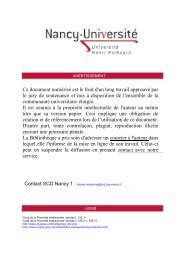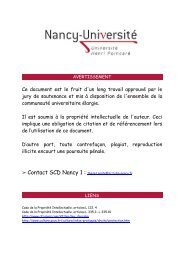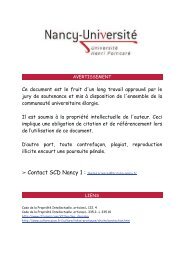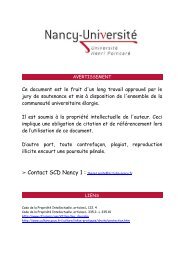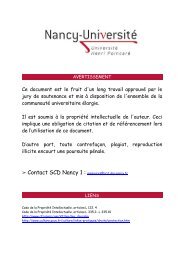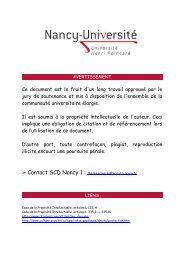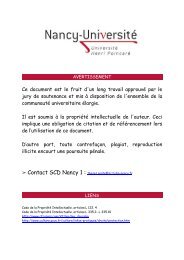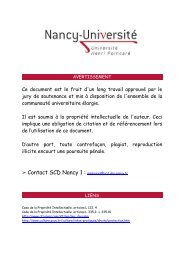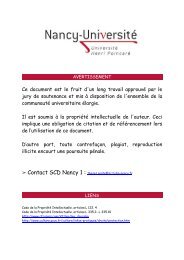Ce document numérisé est le fruit d'un long travail approuvé par le ...
Ce document numérisé est le fruit d'un long travail approuvé par le ...
Ce document numérisé est le fruit d'un long travail approuvé par le ...
You also want an ePaper? Increase the reach of your titles
YUMPU automatically turns print PDFs into web optimized ePapers that Google loves.
PPARs and Human Fetal Dig<strong>est</strong>ive Tract 605<br />
according to Sambrook et al. (1989). Total RNA was extracted<br />
from human fetal int<strong>est</strong>ines (14WD) and from 3T3<br />
L1 cells (passage 58) as described above. 3T3 L1 cells were<br />
chosen for a positive control because those preadipocytes express<br />
PPAR'Y2. Total RNA (5 fLg) was hybridized overnight<br />
with 32p sing<strong>le</strong>-stranded DNA probes (10 5 cpm/samp<strong>le</strong>) at<br />
GOc. After incubation, nonhybridized cDNA was dig<strong>est</strong>ed<br />
by nuc<strong>le</strong>ase Sl (50 U/samp<strong>le</strong>) for GO min at 37C. The DNN<br />
RNA hybrids were resolved by e<strong>le</strong>ctrophoresis and the gel<br />
was exposed ta Kodak film for 24 hI.<br />
Immunohistochemical Analysis<br />
Cryostat sections (3 fLm thick) were fixed in 2% formaldehyde<br />
in PBS for 45 min at 4C and rinsed in PBS. They were<br />
immersed in 100 mM glycine in PBS for 45 min at 4C, then<br />
washed in PBS. The sections were preincubated with a<br />
blocking solution containing 0.1 % fish gelatin, 0.8% bovine<br />
serum albumin, and Tween-80 (2 fLl/l00 ml PBS) for 30 min<br />
at room temperature (RT). They were first exposed to the<br />
primary antibody (diluted 1:250 in PBS/defatted dry milk<br />
5% w/v) for GO min at RT. After two washes in PBS, sections<br />
were exposed to the secondary antibody (1:50 in PBS<br />
BSA 2%), fluorescein-conjugated goat anti-rabbit IgG (Boehringer<br />
Mannheim), for GO min at RT. Negative controls<br />
were performed by replacing the primal'y antibody with PBS<br />
or with preimmune serum. Sections were then mounted in<br />
Vectashield medium and photographed with a Reichert<br />
Jung Polyvar microscope (Vienna, Austria).<br />
Results<br />
Antibody Specificity<br />
In vitro-translated mouse PPARa, f3, and 'Y1 and human<br />
PPAR'Y2 were used for immunoprecipitation assays,<br />
taking advantage of the fact that the human peptide sequences<br />
chosen for immunization are well-conserved<br />
in the corresponding rodent sequences. Figure 2 shows<br />
kDa<br />
Ai<br />
- - -<br />
-<br />
B<br />
kOa<br />
94<br />
67<br />
43<br />
kOa<br />
94<br />
67<br />
43<br />
A<br />
c<br />
_<br />
Anti-PPARa-<br />
1) "(1 "(2<br />
_Anti-PPARyl/y2_<br />
B<br />
·}-;..... l<br />
~,<br />
k..~t...<br />
,-Anti-PPARJ3 _<br />
ex. "(1 "(2<br />
Figure 3 specificity of anti-PPAR antibodies by W<strong>est</strong>ern blotting.<br />
Mouse PPARalpsG5, PPARJ3/psG5, PPAR'Y1/PsG5, and human PPAR'Y2/<br />
pBslIKs+ plasmids were in vitro-translated using reticulocyte lysate<br />
and 1-[35sl-methionine. Translated products were submitted to 505<br />
PAGE (10%). The gels were either subjected to autoradiography (*)<br />
or processed by W<strong>est</strong>ern blotting and ECL using the anti-PPAR antibody<br />
(diluted 1:500) indicated above the different /anes.<br />
o<br />
ex. 1) "(1<br />
94-<br />
67-<br />
43-<br />
30-<br />
that each antibody recognized the PPAR subtype<br />
against which it was raised. When preimmune serum<br />
was used as a control, no signal was obtained. Crossreaction<br />
between each anti-PPAR antibody against the<br />
other PPAR subtypes was absent or very low, as demonstrated<br />
by W<strong>est</strong>ern blotting assays (Figure 3). The<br />
anti-PPAR antibodies produced were also characterized<br />
by W<strong>est</strong>ern blotting using cytosolic extracts from<br />
human adult and fetal colon mucosae. The presence of<br />
the different PPAR subtypes was detected in both sampIes<br />
examined (Figure 4). However, our results indiyi<br />
y2 a. P yI y2<br />
Figure 2 Recognition of the different PPAR subtypes by their respective<br />
antibody. (A) SOS-PAGE analysis of in vitro-translated<br />
mouse PPARa, 13, and "11 and human PPAR'Y2. Two fLl of lysate was<br />
loaded in each lane and analyzed by SOS-PAGE on 10% gels. Oried<br />
gels were exposed for autoradiography. (8) Immunoprecipitation<br />
assay with in vitro-translated mouse PPARa, 13, and "11 and human<br />
PPAR'Y2. Translation product was incubated with the appropriate<br />
primary anti-PPAR antibody (diluted 1:250). The comp<strong>le</strong>xes were<br />
immunoprecipitated using protein A-sepharose, then analyzed by<br />
SOS-PAGE with 9000 cpm for PPARa and PPAR'Y2, 13000 cpm for<br />
PPARJ3, and 16000 cpm for PPAR'Y1. Exposure was 7 days for PPAR'Y2<br />
and 27 days for the other PPARs.<br />
ex. 1) ex. "(2<br />
Figure 4 W<strong>est</strong>ern blotting analysis of PPARa, 13, and "12 expression<br />
in human fetal (A) and adult (B) colon mucosae. Fifty fLg of protein<br />
was run on 15% SOS-PAGE, then transferred cnte a PVOF membrane.<br />
Immunoreactivity of the different PPAR subtypes was detected<br />
by incubation of the membrane with the appropriate primary<br />
antibody (diluted 1: 1000 for anti-PPARa and anti-PPARJ3<br />
antibodies and 1:5000 for anti-PPAR'Y2 antibody). The final reaction<br />
was detected by ECL.



